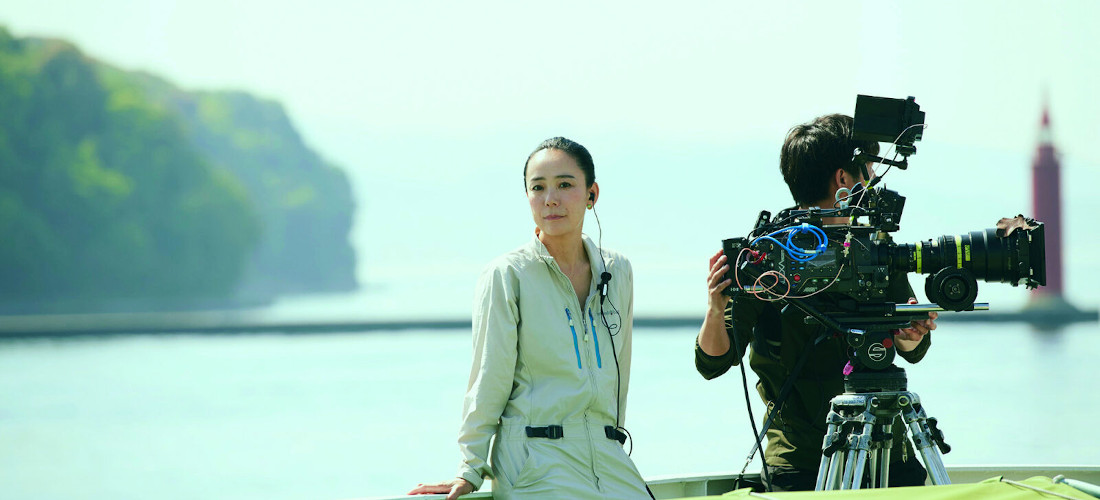Naomi Kawase
Naomi Kawase
“XXXXXXXXXXXX”
BIOGRAFÍA
The inside of a body, exposed. A nourishing, cosmic, previous interior. The warm placenta. Exposed to the light of the cinema, it is bigger than the shot and extends beyond it. Japanese director Naomi Kawase, winner of the MiradasDoc 2023 Personal View Award, presents us with this carnal and initial encounter, with its undeniable mystery, in the opening image of her film Tarachime (Nacimiento y Maternidad, 2006), filmed in first person, when her son Mitsuki was born. It is one of several of her autobiographical pieces which lead us along family fabrics that encompass, from her perspective and her own entrails, care, the life-death cycle with her adoptive mother/great-aunt, abandonment, motherhood and saying goodbye. Domestic annotations that enable her to create a close, allusive, deep and universal experience in the spectator.
For Naomi, our guest author, the youngest woman to receive the Caméra d’Or prize in the Directors’ Fortnight of the prestigious Cannes Film Festival with Moe no Suzaku (1997) -another of the films we are screening in this edition-, the everyday film, the self-referential film that exhibits daily life to exorcize the shadows of the authors and place them at the service of the observer, has been the narrative resource that she has used most since beginning her career as a filmmaker. With such intimate pieces as Ni tsutsumarete (1992), Katatsumori (1994) and Kya ka ra ba a (2001), recorded in Super 8, and with writing that at times operates like haikus – whose greatest declaration of intentions can be found in her one-minute piece Haiku (2009) -, the director managed to carve out a respectable niche for herself in the world of cinema, both in her home country of Japan and internationally, with a work that to this day explores fertile territories of real cinema, fiction and poetry, with an agility and eloquence that make us dream as much and as deeply, as with the photographic work of a contemporary of hers, the acclaimed Rinko Kawauchi. Two voices from different disciplines, enthusiastic and committed to the intimacy of subtle worlds, born almost in unison, from different solitudes, that we could say make up, through their positioning as authors, a magma of creative resistance to other types of visualities of their time and country.
“Let the circle be small, as small as a pumpkin, a good and fair circle to which one can aspire, a circle similar to a moon at its fullest” sings a man in Somaudo monogatari (The Weald, 1997) – another of the movies that will be screened at the festival- at different times in the film. An ancient, inherited song, the bearer of a dance called Yatchon, which almost like a mantra, is borrowed by Kawase to rewrite the recorded images of six villagers and the Yoshino mountains surrounding them. A documentary recorded again in Super 8, which this time reveals a filmmaker who is gradually emerging from herself, as if she had closed some circles and outstanding accounts in her previous works -her adoptive mother, the abandonment by her parents, her loneliness-, to face other realities through her real film. And although her voice, laughter, camera movements (and her entire being, really), accompany the musicality of the piece, we sense that it is only a kind of overlay, a device at the service of amazement, admiration and even naivety, towards people hitherto unknown and alien to her, whose way of being in the world is remote and therefore fascinating, and whose marginal survival coexists with the rhythm of nature, memory and tradition.
“A watering can, a rake abandoned in the middle of a field, a dog lying in the sun, a miserable cemetery, a cripple, a small farm, all of this can become the receptacle of my revelation”, the Austrian author Hugo Von Hofmannsthal confessed to us in his Carta a Lord Chandos (1902). A European voice, which, a century later, would find its echo in the film, for example, of Kawase; a forest, a spiderweb, some bruised breasts, a soft focus, a blinking light. Because although we can never access the depth of a foreign culture, its interior, as the French anthropologist and professor Lévi-Strauss noted in his essay-book The Other Face of the Moon, we have established that that which can address or produce a poem, an image, a documentary, does not necessarily need an identity; it is enough to remain attentive to the ways and beings that surround us, and to let ourselves be amazed by their universal mystery. Like in the award-winning film Moe no Suzaku (1997), which straddles both fiction and documentary, with a now experienced Naomi Kawase, aware that all the silences, all the layers and shapes can collude in the direction of her desires, her philosophy and her sensitivity. It is enough to take a geographical point, a remote town in Nara Prefecture, and sit down and observe. The construction of a train, some people with similar faces, a first writing of the script, and a well-trained gaze and experience. Giving rise to an apparently austere film, though rich in emotion and beauty, where we can also enjoy a debut actor, Machiko Ono, who Kawase herself discovered in her youth and who she would go on to have as a leading actor in future projects, such as Mogari no mori (The Mourning Forest, 2007). Machiko was also the protagonist of the marvellous film Soshite chichi ni naru (Like Father, Like Son, 2013) by Japanese director Hirokazu Koreeda, another of the authors of what we could call the Japanese contemporary “resistance”. The resistance of the intimate, of care, of the subtle.
From first-person accounts, to rural surroundings, and including film correspondence, adolescent drama and urban drama, with titles such as Asa ga kuru (True Mothers, 2020), An (Sweet Bean, 2015) and Futatsume no mado (Still the Water, 2014), Naomi has managed to establish herself as a versatile and sound director, who rubs shoulders with the best of the line-up of Japanese actors, such as Kirin Kiki, Masatosi Nagase and Arata Lura, but also with international actors, such as the experienced Juliette Binoche. She is now surprising us with a new genre, sports film, which has launched her to fame as a renowned director, and which has led her to share the history of cinema with none other than Leni Riefenstahl, director of the spectacular Olympia (Berlin, 2936), but also with Milos Forman (Munich, 1972) and even with Carlos Saura (Barcelona, 1992). Her new work, divided into two films, the Official Film of the Olympic Games Tokyo 2020 Side A (2022) and the Official Film of the Olympic Games Tokyo 2020 Side B (2022), were developed during the Tokyo Olympic Games, which, let us recall, had to be postponed because of the Covid-19 health crisis, and which led the author to create two different narratives. While “Side A”, whose world premiere was in the Cannes Film Festival, deals more with fascination with movement and the body, “Side B” addresses the strains and restrictions of the pandemic before and during the games. This last proposal is now premiering at the Rotterdam Festival (IFFR 2023) and we will be able to enjoy it exclusively at our festival.
María Abenia
Programmer of MiradasDoc
“XXXXXX”.





